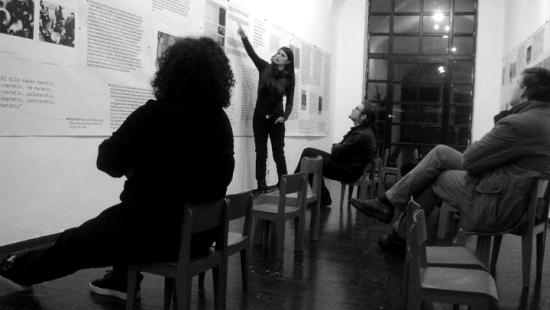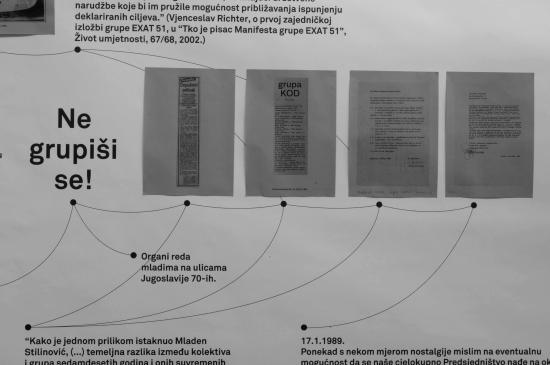The Fate of Other Planets
Galerija Škuc, Ljubljana
23 December 2009 - 15 January 2010
The chapter of RFC presented at the Škuc Gallery focuses on progressive curatorial strategies and innovative exhibition models. The exhibition and walking lecture includes the following chapters: Slip of the History, Non-programmatic Associations of Artists, Engagement vs. Escapism, Impossible Manifestos, Self-organization and Self-institutionalization, History of Curatorial and Exhibition Practices.

Fragment 1: New Collective Practices - Artists’ Association Beyond Manifesto and Program stems from a consideration of the three-year activity of the Podroom Working Community of Artists. Podroom, an artists-led space initiated by Sanja Ivekovic and Dalibor Martinis, was a working and exhibition space that between 1978 and 1981 brought together the key figures of the New Artistic Practice. A transcript of a conversation (a working meeting) held in Podroom and published in the “catalogue-journal” First Issue (1980), which is a summary of the work to date as well as an attempt to sketch out a continuation of the activities of this “community”, serves as a point of departure for the rendering of narrative about self-organised artistic initiatives and the history of associations from Gorgona Group at the beginning of the 1960s to the establishment of the artist –run PM Gallery in Zagreb in 1981. What is common to all the initiatives, irrespective of their duration, is the specific, non-programmatic and organic manner in which they group together around an only adumbrated common goal. The fragment focuses on temporary manifestations of collectiveness, on models of “being singular plural” or more exactly, on being-with as a search for a different understanding of the relation between individual and collective, but also for the point of a collective itself and the possibility of a joint programme. It is precisely in this kind of observation that the transgressivity of working according to the given case or ‘by accident’ is brought out, as well as of acting as a “negative of action”, acting in invisibility, and ultimately - the subversion of the manner in which the dominant ideology at the time was defining the concept of action, collectivity and programme.

Fragment 2: New Curatorial and Exhibition Practices brings the focus to innovative curatorial and institutional practices with the special attention given to the projects initiated and curated by Ida Biard in Zagreb and Paris. The key contribution of curators of the time as well as of the institutions has usually been taken for granted and has rarely been the subject of research in the local art historical narratives. Selected curatorial projects, as well as institutions and informal spaces in which they took place, are here not seen merely in the role of mediators who present artistic products to the audience, but as the active protagonists and initiators of innovative approaches to contemporary art, whether these concern the New Tendencies movement, early conceptual art of the 60s or the New Artistic Practice of the 70s. Moreover, their role is seen as crucial in systematic documentation and timely historization of the innovative artistic practices, enabling them to become relevant point of reference in local art histories and contemporary art and curatorial practice. This emphasis on historization and evaluation of exhibition and curatorial practices represents an initial contribution and a gesture that opens up the discussion and prompts further research in this area.

The subjective methodology of the project launches from the transcript of the aforementioned meeting in Podroom that serves as a loose scenario structuring the very presentation of the research material, the contents of which are original written and visual documents, as well as a collection of more or less arbitrarily connected and disconnected associations, quotes and fragmentary narratives. The title Removed from the Crowd (taken from the title of a piece by Mladen Stilinović) thus becomes a signifier not only of the differentiation of the “associated individuals” as against the ideologically propagated collectivity but also a signifier of the actual methodology. ‘Bits and pieces’ function as a building material for the process of sampling and mixing of images and quotes from catalogues, artist books, our conversations with artists and curators, as well as inserts from sources that don’t explicitly interfere with the artistic context, that are all here overtly, maybe even aggressively, ‘removed’ from their original context to form a number of possible narratives, that reveal art history itself as a performance, relying on subjective processes of selection and interpretation.
Accordingly, the intention of the project is not the creation of a “convincing” and scientifically well-grounded historical or art-historical narrative - it aims rather to indicate an associative cartography functioning as memory script, a map that selects the facts about processes, methodologies and situations we consider to be relevant for us today as well as from a series of speculations derived from the enlargement of details, deliberate omissions, arbitrary connections, all in the aid of articulating a different viewpoint, a temporary and unstable truth through a different “performance” of the writing of the history of contemporary art. Such a ‘subjective methodology’ stems from considerations evolving around the blurred borders of artistic, theoretical and curatorial work, while the output of this processes manifests itself as an open and exploratory endeavour to search for new modes of bypassing the pressures of naming, the new and constant ‘visibility’. The answer to the question why we would today, embark on yet another venture into investigation of art history/memory, lies not so much in the fact that we, as curators and art historians, would wish to contribute new knowledge or innovative discourse when addressing the art of the 60s and 70s. The answer is again of a highly subjective nature: the ‘removed bits and pieces’ represent a set of important references to our own everyday professional practice both in the way of how we perceive ‘working together’, the efforts to withstand the overall precariousness of conditions of production, the pressure of hyper-production that it entails and finally - how we perceive the potential meanings our work might generate. In this sense, both the concept of dematerialisation of art - and one might add, dematerialisation of curatorial work, as well as the models of collaboration, association and ways of constituting the common, typical of the 60s and 70s, become highly relevant again.
Thematically, the exhibition continues the project SKC in ŠKUC, which was carried out by Škuc Gallery in collaboration with Prelom collective in year 2008.
The programme of Škuc Gallery is supported by Ministry of Culture of the Republic of Slovenia and Cultural Department of the City of Ljubljana.
Galerija Škuc, Ljubljana, Slovenia
23 December 2009 - 15 January 2010


